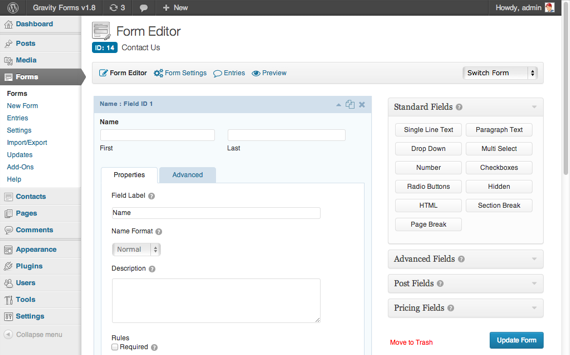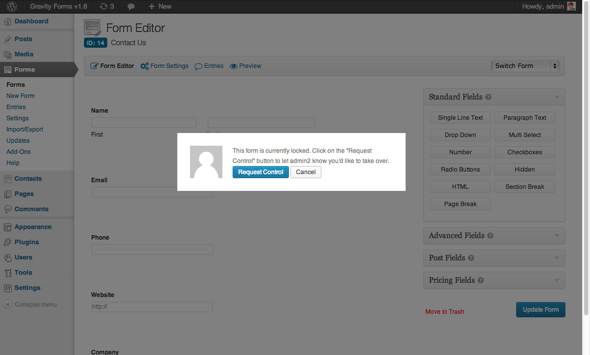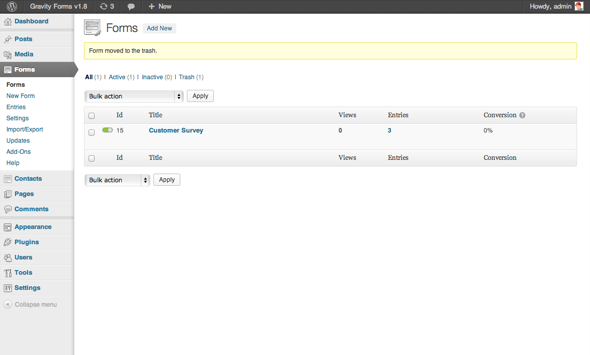Gravity Forms v1.8 Released
Gravity Forms v1.8 is now available via automatic update and the downloads page. This a major feature release that introduces new functionality such as drag-n-drop Multi-File Uploads, Form Trash, WordPress v3.8 UI enhancements, WordPress heartbeat API integration, and much more!
For Developers we are introducing the first official version of the Gravity Forms Add-On Framework and the first version of the Gravity Forms API. Both of these developer focused features will make it even easier for developers to bend Gravity Forms to their will.
The Add-On Framework and API are great news for users because it means even more 3rd party Add-Ons and customizations will follow! The Add-On Framework and API aren’t just for 3rd party developers, they also set up Gravity Forms for some very big things going forward.
2014 will be a big year for Gravity Forms. We will be taking both Gravity Forms and our customers well beyond Forms and we’re glad you are along for the ride! We’re very excited about our future plans. We’ve only just begun!
Let’s get down to what you want to know, what is new in Gravity Forms v1.8?
Multi-File Upload

The File Upload field now supports multi-file uploads! But we didn’t stop there, we have incorporated the same file upload functionality utilized by WordPress itself. This allows you to enable drag-n-drop file upload fields.
Along with being able to upload multiple files, there are additional new settings such as: maximum number of files and maximum file upload size.
UI Refinements

We have standardized the iconography utilized within Gravity Forms and the Add-On Framework to utilize web fonts.
We have chosen to standardize using Font Awesome. This provides us with a rich library of iconography that we can use within Gravity Forms, our Add-Ons and 3rd party developers can easily leverage in their own Add-Ons and customizations. This helps provide a consistent look across the board while still fitting in with the look and feel of WordPress itself.
With Gravity Forms v1.8 we have begun this transition. We will continue to refine this going forward.
WordPress Heartbeat Integration

Gravity Forms now makes use of the Heartbeat API within WordPress. What is the Heartbeat API? It allows WordPress to know when multiple users are viewing or editing the same thing at the same time. It is used to help prevent multiple people from trying to make changes to the same thing at the same time.
We have integrated this conflict resolution functionality within Gravity Forms to prevent multiple users from editing: Forms, Entries, Form Settings or Gravity Forms Settings. Entries can still be viewed if someone is editing it; however, it will let you know on the Entry Detail page that a user is editing the entry. The Entry Editor will not be enabled if someone else is editing the entry.
We have also implemented the ability to request and hand off control of editing from one user to another. This is very important because once control is passed, any unsaved changes will not be saved. So it’s important to be able to deny a request to take control of editing a Form or Entry until after changes have been completed.
Form Trash

Forms now have their own Trash functionality that works just like the Entries trash. This prevents you from accidentally deleting a Form, which in turn deletes all the Entries associated with a Form. You can now breath easy that you can’t accidentally delete a Form and it’s Entries with a single click.
When a Form has been added to the Trash it will no longer appear as an available Form on the site. Its entries will also be hidden until it is either restored from trash or deleted permanently.
Other Enhancements
- Enhanced Entry Search
- You can now search entries for the value of specific fields as well as use operators such as “is”, “is not”, “contains”, etc. The operators available will depend on the field type selected.
- Enhanced Entry Export
- The Entry Export now allows you to apply Conditional Logic so that only the entries that meet certain criteria will be exported.
- Page Confirmation Query String
- When opting to redirect to a WordPress Page for the Confirmation you can now pass custom query string parameters as you can with the Redirect Confirmation.
- Notification Enhancements
- Notifications can now be set as active/inactive as well as duplicated.
- Confirmation Enhancements
- Confirmations can now be set as active/inactive as well as duplicated.
- Post Category Field Hierarchy
- The Post Category Field when configured to only show selected categories will now maintain the category hierarchy automatically.
- Form Scheduling
- Form Scheduling now allows you to display a custom message when the form cannot be displayed because the Start Date has not yet begun.
- Form Sorting
- The Form List page that lists all of your Forms now supports sorting on the columns so you can sort by id, name, etc.
- WordPress Multi-Site
- Gravity Forms now supports being installed within the MU-PLUGINS folder on WordPress Multi-Site installations.
Add-On Framework
The Add-On Framework provides basic functionality for developers when creating new add-ons for Gravity Forms. Here is some of the things it can do for Add-On developers:
- Initialization
- Enforcing Gravity Forms minimum version requirement
- Creating settings pages (both add-on and form settings)
- Creating form feeds
- Creating results pages for Add-Ons that display results like Surveys, etc.
- And much more…
Find out more about the Gravity Forms Add-On Framework and view its documentation to find out more!
API
The Gravity Forms API provides developers with a future-proof way to access some of the common core functionality in Gravity Forms. There are two ways to leverage the API: API Functions in the GFAPI class or Via HTTP using the Web API. The API can be used to add, update, delete and return Gravity Forms data such as forms and entries.
As with the Add-On Framework, you can find out more about the brand new Gravity Forms API and view its documentation to find out more!
These are the major features and enhancements made in this release. There are other enhancements, new hooks etc. but they are simply too numerous to cover in this post. For a complete rundown of all of the updates, enhancements, bug fixes, etc. you can check out the complete changelog file within the release zip file. Enjoy!
Please Note: With the exception of the Add-On Framework and API, Documentation for the features and functionality introduced in Gravity Forms v1.8 is still in progress. We are completely overhauling all of the Gravity Forms documentation and will be launching an entirely new site soon.
You can update to the latest version of Gravity Forms using Automatic Update. Just visit the Updates page under the Forms navigation in your WordPress Dashboard. Update deployment is staged so if you do not see the update available, try again in a few hours. You can also download the latest version of the plugin from the Downloads page.
